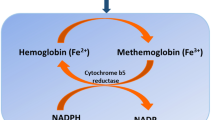Summary
The currently recommended dosage regimen for méthylène blue (intermittent bolus dose) in the treatment of methaemoglobinaemia caused by dapsone is often inadequate. This is due to the long half-life of dapsone which provides a continuing oxidative stress that can cause a recurrence of clinically significant methaemoglobinaemia. Methylene blue infusion is effective, as demonstrated in an illustrative case report, and should be supported by repeated doses of activated charcoal to enhance dapsone elimination. The principles of treatment of methaemoglobinaemia due to dapsone can be applied to methaemoglobinaemia due to any agent producing prolonged oxidative stress.
Similar content being viewed by others
References
Berlin G, Brodin B, Hilden J, Martensson J. Acute dapsone intoxication: a case treatment with continuous infusion of methylene blue, forced diuresis and plasma exchange. Clinical Toxicology 22: 537–548, 1985
Cooke TJL. Dapsone poisoning. Medical Journal of Australia 1: 1158–1159, 1970
Cucinell SA, Israili ZH, Dayton PG. Microsomal N-oxication of dapsone as a cause of methemoglobin formation in human red cells. American Journal of Tropical Medicine and Hygiene 21: 322–331, 1972
Dacie JV, Lewis SM. Recognition and measurement of abnormal haemoglobin pigments. In Practical haematology, 6th ed., pp. 147–149, Churchill Livingstone, Edinburgh, 1984
Davies R. Fatal poisoning with udolag (diaminodiphenylsulphone). Lancet 1: 905, 1950
Elonen E, Neuvonen PJ, Halmekoski J, Mattila MJ. Acute dapsone intoxication: a case with prolonged symptoms. Clinical Toxicology 14: 79–85, 1979
Endre ZH, Macdonald GJ, Charlesworth JA, Woodbridge L. Successful treatment of acute dapsone intoxication using charcoal hemoperfusion. Australian and New Zealand Journal of Medicine 13: 509–512, 1983
Glader BE, Conrad ME. Hemolysis by diphenylsulphones: comparative effects of DDS and hydroxylamine-DDS. Journal of Laboratory and Clinical Medicine 80: 267–272, 1973
Goldstein BD. Exacerbation of dapsone-induced Heinz body hemolytic anemia following treatment with methylene blue. American Journal of the Medical Sciences 267: 291–297, 1974
Goluboff N, Wheaton R. Methylene blue induced cyanosis and acute hemolytic anemia complicating the treatment of methemoglobinemia. Journal of Pediatrics 58: 86–89, 1961
Grossman SJ, Jollow DJ. The role of dapsone hydroxylamine in dapsone-induced hemolytic anemia. Journal of Pharmacology and Experimental Therapeutics 244: 118–125, 1988
Hall AH, Kulig KW, Rumack BH. Drug and chemical induced methaemoglobinaemia: clinical features and management. Medical Toxicology 1: 253–260, 1986
Harris JC, Rumack BH, Peterson RG, McGuire BM. Methemoglobinemia resulting from absorption of nitrates. Journal of the American Medical Association 242: 2869–2871, 1979
Hedstand H. A case of acute side-reactions to diaminodiphen-ylsulphone (DDS). Acta Dermato-Venereologica 48: 528–531, 1968
Hjelm M, De Verdier CH. Biochemical effects of aromatic amines. 1. Methaemoglobinaemia, haemolysis and heinz-body formation induced by 4,4′-diaminodiphenylsulphone. Biochemical Pharmacology 14: 1119–1128, 1965
Jaeger A, Sauder P, Kopferschmitt J, Flesch F. Clinical features and management of poisoning due to antimalarial drugs. Medical Toxicology 2: 242–273, 1987
Kenner DJ, Holt K, Agnello R, Chester GH. Permanent retinal damage following massive dapsone overdose. British Journal of Ophthalmology 64: 741–744, 1980
Kramer PA, Glader BE, Ting-Kai L. Mechanism of methemoglobin formation by diphenylsulphones. Biochemical Pharmacology 21: 1265–1274, 1972
Lambert M, Sonnet J, Mahieu P, Hassoun A. Delayed sulfhemoglobinemia after acute dapsone intoxication. Journal of Toxicology — Clinical Toxicology 19: 45–50, 1982
Manfredi G, De Panfilis G, Zampetti M, Allegra F. Studies on dapsone induced haemolytic anaemia. British Journal of Haematology 100: 427–432, 1979
Nair PM, Philip E. Accidental dapsone poisoning in children. Annals of Tropical Paediatrics 4: 241–242, 1984
Neuvonen PJ, Elonen E, Haapanen EJ. Acute dapsone intoxication: clinical findings and effect of oral charcoal and haemodialysis on dapsone elimination. Acta Medica Scandinavica 214: 215–220, 1983
Neuvonen PJ, Elonen E, Mattila MJ. Oral activated charcoal and dapsone elimination. Clinical Pharmacology and Therapeutics 27: 823–827, 1980
Park CM, Nagel RL. Sulfhemoglobinemia: clinical and molecular aspects. New England Journal of Medicine 310: 1579–1584, 1984
Reigart JR, Trammel HL, Lindsey JM. Repetitive doses of activated charcoal in dapsone poisoning in a child. Journal of Toxicology — Clinical Toxicology 19: 1061–1066, 1983
Rosen PJ, Johnson C, McGehee WG, Beutler E. Failure of methylene blue treatment in toxic methemoglobinemia: association with glucose-6-phosphate dehydrogenase deficiency. Annals of Internal Medicine 75: 83–86, 1971
Scott GL, Rasbridge MR. The in vitro action of dapsone and its derivatives on normal and G6PD-deficient red cells. British Journal of Haematology 24: 307–317, 1973
Stanfield JP. A case of acute poisoning with dapsone. Journal of Tropical Medicine and Hygiene 66: 292–295, 1963
Sturt J. Too much of a good thing. Papua New Guinea Medical Journal 10: 97, 1967
Whitman JG, Taylor AR, White JM. Potential hazard of methylene blue. Anaesthesia 34: 181–182, 1979
Woodhouse KW, Henderson DB, Charlton B, Peaston RT, Rawlins MD. Acute dapsone poisoning: clinical features and pharmacokinetic studies. Human Toxicology 3: 507–510, 1983
Zuidema J, Hilbers-Madderman ESM, Merkus FWHW. Clinical pharmacokinetics of dapsone. Clinical Pharmacokinetics 11: 299–315, 1986
Author information
Authors and Affiliations
Rights and permissions
About this article
Cite this article
Dawson, A.H., Whyte, I.M. Management of Dapsone Poisoning Complicated by Methaemoglobinaemia. Med Toxicol Adverse Drug Exp 4, 387–392 (1989). https://doi.org/10.1007/BF03259920
Published:
Issue Date:
DOI: https://doi.org/10.1007/BF03259920




